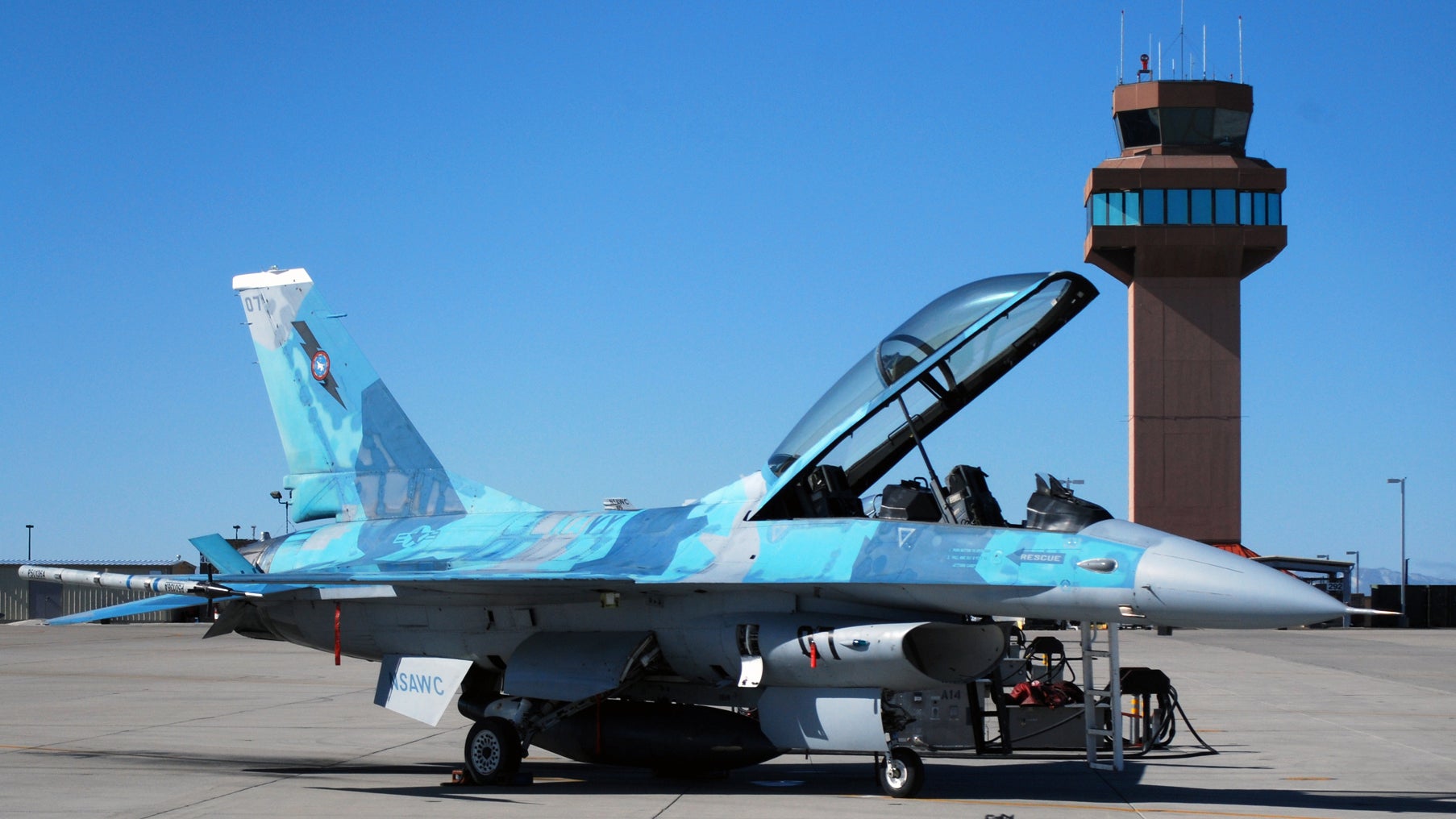The U.S. Navy is moving ahead with plans to introduce more F-16 Viper fighter jets to replace ‘legacy’ F/A-18 Hornets used in the adversary role. The War Zone has reported in the past about Navy aspirations to add ex-Air Force Vipers to its ranks, and originally broke the story when it was still little more than a crewroom rumor. Now part of the Pentagon’s formal budget request for the 2022 Fiscal Year, which you can read more about here.
The request seeks to accelerate the retirement of the Navy’s remaining ‘legacy’ F/A-18A/B/C/D Hornets and the acquisition of replacement aggressor jets for a portion of these jets should help achieve that. Already operated exclusively by Reserve units, the ‘legacy’ Hornets are now to be retired by 2022, two years earlier than planned, with around 55 examples slated to go over the next 12 months. Among these are some of the Navy’s most important adversary airframes that frequently push fleet pilots to their limits.

According to the documents released today as part of the budget request, an additional 26 F-16s are being sought by the Navy, with plans to transfer these from the Air Force beginning in 2022. The aircraft will comprise 20 single-seat Block 32 F-16Cs and six two-seat Block 25 F-16Ds. The F-16Cs “will be upgraded to maintain common configuration with the USAF program,” according to the Navy and will be supported by contracted maintainers, with the aim of saving money.
Under the latest budget plans, the Air Force plans to divest 47 of its oldest F-16C/Ds, part of a wider plan to retire 124 Vipers by 2026. The aim of that initiative is to provide an Air Force fleet that consists only of Block 40 models and later. Quoted in Seapower Magazine
earlier this year, Vice Admiral John Mustin, chief of Navy Reserve, said that the second-hand F-16s would be drawn from Air Force and Air National Guard stocks.
The reason the F-16s are required at this point is that there simply aren’t enough Super Hornets available to equip frontline and training units as well as support the high-end adversary mission; the Navy wants to stop buying F/A-18E/Fs entirely in FY22. So far, only VFC-12, the “Fighting Omars,” based at Naval Air Station Oceana, Virginia, is in line to receive Block 1 F/A-18E/Fs for the red air mission. You can read more about their transition to the Super Hornet in this special feature of ours. The Naval Air Warfighting Development Center (NAWDC), which includes Topgun, also operates a handful of F/A-18E/Fs, too.
The Vipers will join an overall Navy adversary fleet that already includes 15 F-16s (10 single-seat F-16As and four two-seat F-16Bs) that are operated primarily by Topgun instructors at Naval Air Station (NAS) Fallon, Nevada. These comprise part of the high-end Navy adversary fleet, which is currently being bolstered by the F/A-18E/F Super Hornets that are now going to VFC-12.

Supplementing the high-end assets, the low- to mid-end adversaries comprise 43 F-5 Tiger IIs (40 single-seat F-5Ns and three two-seat F-5Fs), with another 22 F-5s (16 single-seat F-5Es and six F-5Fs) procured from the Swiss government last year are due to be upgraded prior to entering service.
That still leaves a requirement to replace the ‘legacy’ Hornets with VFA-204, the “River Rattlers,” based at Naval Air Station Joint Reserve Base (NAS JRB) New Orleans, Louisiana. While this squadron might seem like the obvious candidate for the F-16s, sources tell The War Zone that these Vipers will join VFC-13, the “Saints,” at Fallon, since the type is already operated at the Nevada base, and it also offers considerable range space. NAS Fallon is also where critical training is done for carrier air wing workups and fighter tactics instruction, as well as tactics development and more. In the process, VFC-13’s current F-5s will go to VFA-204.

The budget request confirms plans to operate the F-16s and F-5s through 2035, as they continue to provide a red air threat for Fleet Replacement Squadron, Carrier Strike Group, Carrier Air Wing, and Unit Deployment Plan training programs.
Of course, Navy aggressor F-16s are hardly a entirely new concept. During the mid-1980s, the service acquired 26 examples of the bespoke F-16N version as part of an overhaul of its adversary fleet to better replicate newer threats like the MiG-29 Fulcrum and Su-27 Flanker. You can read more about these especially capable Vipers in this previous feature, although their career was short, with retirement following in the mid-1990s.

The Navy again moved for Vipers in 2002-03, when 14 F-16A/Bs were transferred to the Naval Strike and Air Warfare Center (NSAWC) primarily for use by the Topgun program. These jets had been manufactured for Pakistan before an embargo prevented their delivery.

The F-16, in general, is currently in the ascendancy as an aggressor asset in the United States. As well as the Air Force’s 18th Aggressor Squadron (AGRS) at Eielson Air Force Base in Alaska and the 64th AGRS at Nellis Air Force Base in Nevada, the type is now also flying with a private contractor, Top Aces, whose ex-Israeli F-16s you can also read about here and here.
Now that the Super Hornet is joining VFC-12, the addition of F-16s to the Navy ‘bandit’ fleet will also ensure that strike fighter pilots are exposed to dissimilar high-end types, too.
So, with the Navy set on acquiring a significant number of additional F-16s, and with a fast-paced timeline to get them into service, it shouldn’t be long before we get to see exactly how these aggressor Vipers will be employed.
Contact the author: thomas@thedrive.com
